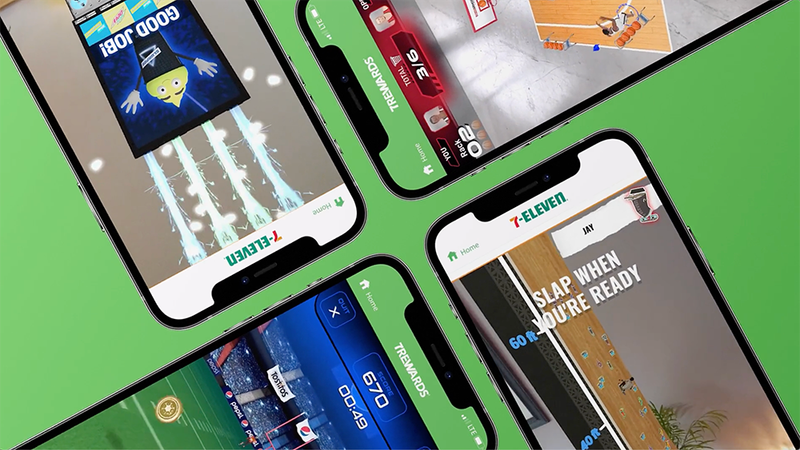AR is no longer a novelty, but a powerful tool, that when incorporated into your business strategy can help to drive sales, increase engagement and maximise budgets.
The value that AR brings is evolving. For years now, research has shown the impact it can have when it comes to building awareness and increasing engagement.
- 95% increase in visual attention
- 45% higher attention than TV or online browsing
- 70% uplift in memory encoding and all-important memory recall
Source: Mindshare / Neuro Insight
However, with the digital acceleration sparked by COVID, in terms of product visualisation, we are now seeing the impact of AR much further down the purchase funnel, with regards to building consumer confidence and in turn leading to greater active consideration, registration and sales.
- 94% higher conversion rates for products with AR content.
- 56% of shoppers agree AR gives them more confidence about product quality.
- 40% of UK consumers use their mobile while browsing in-store to cross-check pricing.
Therefore, AR has become a tool that can be used to great effect throughout the consumer journey as part of your commercial strategy as well as within your other business functions including communications, learning & development and new product development.
We encourage people not to think about AR (the technology) but think of the camera and the lens it places on the world for digital discovery to solve existing problems or unlock new opportunities and solutions (the long term strategy). Whether that’s as a new customer engagement channel for your marketing messaging or adding entirely new owned media touchpoints and opportunities to your media real estate and inventory.
Moving away from one-off campaigns to an always on calendar of content
Delivering a complete AR camera strategy does require a new way of thinking, it means breaking out of POC’s and one-off campaigns and thinking more holistically as well as longer term. The trap many businesses fall into is thinking about XR vertically in their comms planning, plotting out one siloed activation after the next with singular campaigns, promotional periods or season only content. And whilst you’ll still get good results from these, you won’t build economies of scale over time.
What we encourage is for our partners to think horizontally; how can AR be used across your business and commercial strategy? Make AR part of your digital architecture and toolkit by first building it into your IT systems, integrated with your data system, digital asset management system and QR generation platform first from the start. Consider how to utilise existing and evergreen content that will communicate everything from brand purpose to sustainability so that they can be used across channels and collateral on an ongoing basis.
Once you’ve established that foundation, then you can layer on campaign and promotional activity. This content can be updated and refreshed over time without the need to reproduce material - allowing for a consistent flow of newer content that sits alongside your evergreen content.
Adding AR to your existing material
Your existing, deployed real estate and collateral could have a digital lens and camera capability built into it. Once your story exists in AR it can be played out through all channels simply with a QR code or deep link (for email or social media). You have the media and marketing real estate to use so why waste it if every touchpoint can drive home your message? AR is going to connect everything - places, print, products, POS, spaces and faces in the coming years for an increasingly ‘AR native’ Gen Z audience.
Brands and businesses need to think about how they can deliver practical, everyday value through contextually relevant experiences to their users and incorporate this into what they already use and are familiar with. Two clear examples where this holds considerable value are packaging and in-store materials.
With packaging, a code and Call to Action is permanently designed into the label or pack to deliver a regular stream of content which can be updated seasonally without changing the design. This series of content updates can be executed to deliver major promotions around annual events, such as Christmas, and then more practical information at other times of year, driving purchase and replenishment. Nestle for example, connected a series of their products to recipe video content designed to inspire consumers and offer simple information relevant at point of consumption.
In-store you can create interactive experiences that are connected to your static, passive in-store materials as permanent digital display points. As with packaging, this allows them to be easily updated and refreshed over time (whilst also reducing operational costs) increasing engagement, giving your customers a reason to return time and time again.
Tips for integrating AR into your wider business strategy
Focus on the now. It is a mistake to spend too much time thinking ahead to the next technological advance and not take advantage of what is already here. Most of the functionality you really want to use has been possible for at least five years, it is just that phones have got better and distribution more accessible with WebAR. There is now no barrier for brands and business other than internal operational ones.
Build strong foundations from the start. Your strategy is not just about technology, it’s about internal structure, clear direction and a tight process that is understood throughout the organisation. Take the time to ensure there is consistent training & communication throughout.
Be realistic. Think carefully about what your organisation is capable of as well as your local markets and their individual digital transformation journeys. What is the familiarity and understanding as well as the network capabilities and device range?
Move from innovation to everyday. Your end goal should be to take AR out of the innovation team and pass it over to your marketing and brand teams. Your digital innovation team shouldn't need to be overseeing the technology but instead it should become another tool for the marketing and brand teams to execute.
In the next decade we’re going to be using cameras more, not less. Product discovery, consideration and purchase will increasingly be influenced by spatial storytelling, especially amongst the growing Gen Z audience. We believe AR is the new space race and brands that build the right foundations now will have the competitive advantage. This is about building total solutions that are robust, scalable, flexible and efficient that can be applied to all areas of your business.
 Caspar Thykier
Caspar ThykierCo-Founder & CEO, Zappar
